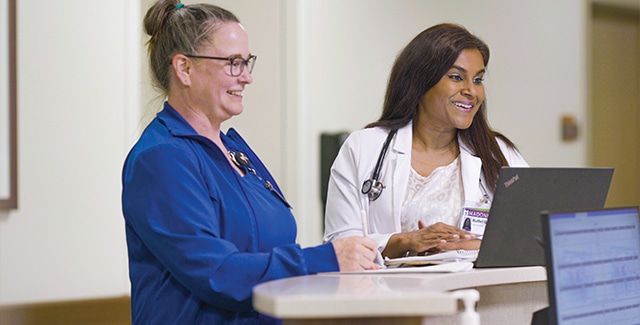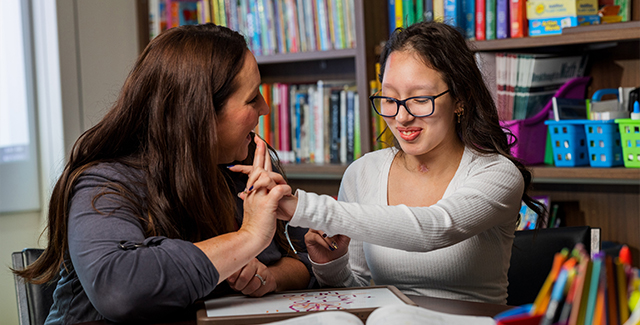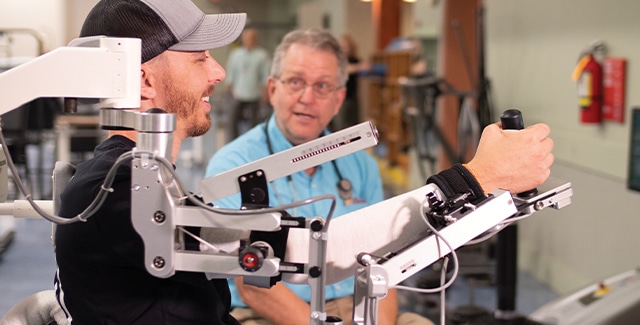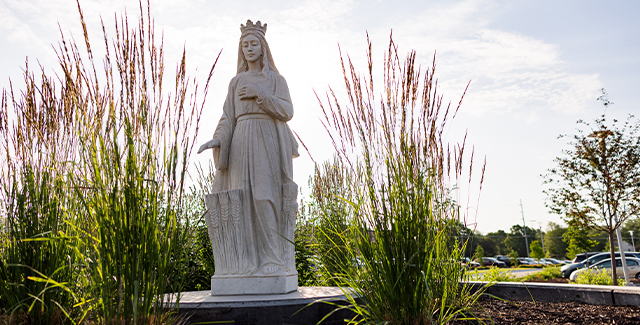Since he started his career six years ago, Daniel ‘Danny’ Rivera has done electrical work for organizations ranging from schools to grocery stores and even jails. For him, lighting and wiring go beyond just work. It’s truly his passion.
“You just can’t not look at it,” Danny said. “Even before I was an electrician, I was still looking up at stuff. It’s just what I’m meant to be doing, I guess.”
His physician-led care team at Madonna Rehabilitation Hospitals not only encouraged Danny to set a goal of returning to work. They made his career part of his care plan. Danny’s occupational therapist, Jessica Virgil, MOT, OTR/L, CBIS, reached out to Madonna’s electrician, Joe Schroeder, to create small real-world tasks for Danny to work on.
“He talks about work all the time, so he has a true passion for what he does and I wanted to get him back into that,” Virgil said.
Early in his recovery from a brain injury, Danny dealt with confusion, oftentimes thinking he was at work or needing to complete work tasks. He was injured while on the job but doesn’t remember the accident.
“He was working on a project and, from what I was told, he reached up and grabbed some wires that weren’t put in properly and got electrocuted,” Beth Emery, Danny’s mom, said. “He fell off of an eight-foot ladder and he still had a hold of the wires when he landed.”
Danny was taken to Overland Park Regional Medical Center in Kansas City. He spent three weeks there before coming to Madonna’s Specialty Hospital to start rehabilitation. He benefited from Madonna’s brain injury program and specialized services for injured workers, maximizing his recovery. With an extended stay, he progressed through Madonna’s continuum of care and actively engaged in community reintegration programs.
From day one, Danny made it clear he wanted to be able to safely perform his job duties and provide a living for his family. As his cognition improved, Madonna’s therapy team leaned into his desire to return to work.
“He actually was moving fairly well,” Virgil said. “He had some mild balance instability, but I feel like the biggest barrier for him was more his language, being able to find the words he wanted to say. I really wanted to work on those and challenge him using routine work tasks.”
Virgil helped Danny fill out a work readiness assessment and connected with Schroeder on tasks that would be appropriate for his skill level and where he was at in his recovery. Under the guidance of Schroeder, Danny replaced lightbulbs and ballasts and shortened an electrical cord.
“That’s awesome for people, especially in a skilled trade,” Schroeder said. “There’s always something around here we’re doing and they can get involved. It’s really good for them to get back out in the real world, but in a controlled setting so they can get help if they need it.”
For Danny, getting his hands on wiring again made things start to click in his mind.
“I was really kind of impressed by the amount that did come back,” Danny said. “Obviously you’re going to forget things, and that’s fine, but the stuff that did come back, I was like, ‘Oh, ok, alright. This is it! I’m in it.’”
His mom was in his room when he returned from his first session of work re-entry.
“He was just beaming,” she remembered.
While Danny did more commercial electrical work and says hospitals like Madonna have unique wiring, he says it was good to just get back into the swing of things.
“I know this was just kind of a baby step into what he was doing and getting him back to doing so,” Virgil said. “It was good to see him in his profession and what he knew. He was excited to get back to that hands-on work.”
Madonna’s work re-entry program extends beyond skilled trades. Therapists think outside the box and use every inch of the hospital campuses to simulate work tasks in a variety of fields.
“Most of our patients here are working individuals and have a strong desire to get back to work,” Virgil said. “We have so many people around the hospital that are willing to step up and bring these patients in to be able to get back to their life.”
For Danny, it was electrical work, but Virgil says she’s helped patients simulate their jobs in Madonna’s salon, doing chapel work, and even stocking shelves in the purchasing department. Even if a person’s exact job isn’t available at Madonna, therapy collaborates with a person’s place of employment to create or simulate tasks that would be similar in nature or that employ skills one would need to be successful in that role.
“It’s not even just getting them back to doing exactly what they were doing for work, but seeing how they do with some of those higher-level cognitive abilities,” Virgil said. “For example, to be able to manage their time. As part of the program, we have to have them clock in and out at the volunteer office, so also remember where that is and where to go with their pathfinding skills. We also look at things like organization and problem-solving.”
The work re-entry program benefits patients, but also allows Madonna support staff like Schroeder to be part of the recovery journey in a unique way.
“I like to see people getting back out there and getting ready to work again, getting back to life,” Schroeder said.
As Danny transitions to the next phase in his recovery journey, he says his “job” is to get stronger and prepare for a return to his community. However, he expects to be back on a construction site soon.
“A lot of it is his strong will and his hardheaded stubbornness,” his mom said. “But the rest of it is this staff and this facility has just been phenomenal. He was blessed with the opportunity to come here to get the help that he needed. His employer has been super supportive, and I feel like, with such a serious accident, God put him exactly where he needed to be and with the people he needed to get him back to his life.”





